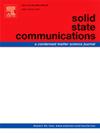基于 CIGS-Sb2S3 组合的太阳能电池的性能和热稳定性,其功率转换效率大于 35
IF 2.1
4区 物理与天体物理
Q3 PHYSICS, CONDENSED MATTER
引用次数: 0
摘要
本研究介绍了一种利用 CIGS(铜-铟-镓-硒)吸收体和 Sb2S3(三硫化锑)背表面场 (BSF) 层的太阳能电池设计,其目标是实现高光伏 (PV) 性能,并强调尽可能降低环境温度的影响。我们使用 SCAPS-1D 软件模拟了由氧化锌、表面缺陷层、硫化锌、CIGS 层和 Sb2S3 层组成的太阳能电池设计。我们的研究结果表明,200 nm 的 Sb2S3 层和 1600 nm 的 CIGS 层是实现拟议太阳能电池的高光电性能和适当 J-V 特性的首选组合。在这种设计中,VOC(开路电压)、JSC(短路电流密度)、PCE(功率转换效率)和填充因子(FF)分别达到了 1.069V、42.08 mA/cm2、35.94 % 和 80.31 %。拟议太阳能电池的光伏性能大大优于不含 BSF 层的太阳能电池设计以及最近报道的太阳能电池设计(2023-24 年)。本研究进一步探讨了环境温度升高(295-360 K)对光伏性能的影响。我们的模拟结果表明,由于功率温度系数较小(每开氏度-0.034 %),与市售太阳能电池的功率温度系数相当,因此在适度升高的温度下操作所提议的太阳能电池并不是一个重大问题。这些发现有望推动光伏太阳能电池的不断进步,从而实现更高的 PCE 和更高的稳定性,包括热稳定性。拟议的太阳能电池具有低 PTC 和高 PCE,可适用于温度波动剧烈的空间应用以及热带地区。本文章由计算机程序翻译,如有差异,请以英文原文为准。
On the performance and thermal stability of solar cell based on CIGS-Sb2S3 combination with >35 % power conversion efficiency
This study presents a solar cell design utilizing a CIGS (copper-indium-gallium-selenide) absorber and Sb2S3 (antimony trisulfide) back surface field (BSF) layers, targeting high photovoltaic (PV) performance with an emphasis on minimum possible effect of ambient temperature. We simulated a solar cell design consisting of zinc oxide, surface defect layer, zinc sulfide, CIGS layer, and an Sb2S3 layer using SCAPS-1D software. Our findings indicate that 200 nm Sb2S3 layer and a 1600 nm CIGS layer is the preferred combination for achieving high PV performance and appropriate J-V characteristics of the proposed solar cell. For this design, the achieved values of VOC (open circuit voltage), JSC (short circuit current density), PCE (power conversion efficiency), and fill factor (FF) are 1.069V, 42.08 mA/cm2, 35.94 %, and 80.31 %, respectively. The PV performance of the proposed solar cell is substantially better than the solar cell design without BSF layer as well as recently reported (2023-24) solar cell designs. This study further examines the impact of elevated ambient temperatures (295–360 K) on the PV performance. Our simulation results show that operating the proposed solar cell at moderately elevated temperatures is not a significant issue owing to small power temperature coefficient (−0.034 % per K), which is comparable to that of commercially available solar cells. These findings are expected to contribute to the ongoing advancement of PV solar cells, aiming for higher PCE and improved stability, including thermal stability. Proposed solar cell with low PTC and high PCE can be suitable for space applications where temperature fluctuation is severe, as well as in tropical areas.
求助全文
通过发布文献求助,成功后即可免费获取论文全文。
去求助
来源期刊

Solid State Communications
物理-物理:凝聚态物理
CiteScore
3.40
自引率
4.80%
发文量
287
审稿时长
51 days
期刊介绍:
Solid State Communications is an international medium for the publication of short communications and original research articles on significant developments in condensed matter science, giving scientists immediate access to important, recently completed work. The journal publishes original experimental and theoretical research on the physical and chemical properties of solids and other condensed systems and also on their preparation. The submission of manuscripts reporting research on the basic physics of materials science and devices, as well as of state-of-the-art microstructures and nanostructures, is encouraged.
A coherent quantitative treatment emphasizing new physics is expected rather than a simple accumulation of experimental data. Consistent with these aims, the short communications should be kept concise and short, usually not longer than six printed pages. The number of figures and tables should also be kept to a minimum. Solid State Communications now also welcomes original research articles without length restrictions.
The Fast-Track section of Solid State Communications is the venue for very rapid publication of short communications on significant developments in condensed matter science. The goal is to offer the broad condensed matter community quick and immediate access to publish recently completed papers in research areas that are rapidly evolving and in which there are developments with great potential impact.
 求助内容:
求助内容: 应助结果提醒方式:
应助结果提醒方式:


